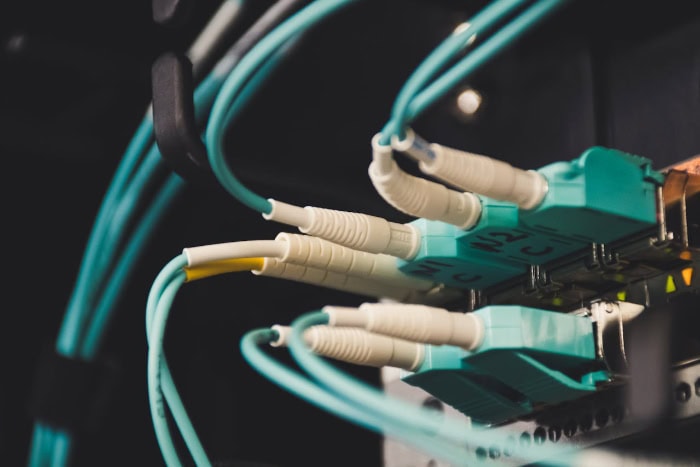What Is a Distributed Denial-of-Service (DDoS) Attack?

A sudden, unexplained service outage can bring an entire operation to its knees, often signaling a distributed denial-of-service (DDoS) attack. These coordinated assaults weaponize a swarm of computers to flood a target with junk traffic, effectively jamming the digital front door and blocking legitimate users.
The motives are varied, ranging from simple vandalism and extortion to creating a diversion for more covert cyber intrusions.
Defining DDoS Fundamentals
The fundamental goal of a distributed denial-of-service attack is to disrupt operations by making a server, service, or network inaccessible. Attackers accomplish this by consuming the target's resources with traffic from numerous sources.
The Anatomy of a DDoS Attack
A DDoS attack operates on a simple principle: overwhelming a target with more requests than it can handle. By using a multitude of systems, attackers can generate a massive volume of traffic aimed at the target’s network bandwidth, server protocols, or specific applications.
This barrage consumes the target’s resources, such as CPU, memory, or network capacity, until its performance degrades significantly or it fails completely, resulting in a denial of service for legitimate users.
Differentiating DoS and DDoS
The main distinction between a denial-of-service (DoS) and a distributed denial-of-service (DDoS) attack lies in the number of sources. A DoS attack originates from a single source, making it relatively straightforward to identify and block the malicious IP address.
A DDoS attack, however, is launched from many different sources simultaneously. This distributed approach makes it far more difficult to distinguish malicious traffic from legitimate requests, complicating tracing and filtering efforts for defenders.
Attack Amplification and Botnets
The scale and impact of DDoS attacks are often magnified through botnets and amplification techniques. A botnet is a network of internet-connected devices, such as computers, servers, and IoT devices, that have been infected with malware and are controlled by an attacker.
These compromised devices, or “bots,” can be commanded to send traffic to a single target. Attackers also use reflection and amplification methods, where they send requests to publicly accessible servers (like DNS or NTP servers) that are spoofed to appear as if they originated from the victim.
The servers then send a much larger response to the victim's IP address, amplifying the initial attack traffic many times over.
Common Attack Types and Mechanisms

DDoS attacks are not a monolithic threat; they are categorized based on which layer of the Open Systems Interconnection (OSI) model they target. Attackers exploit different vulnerabilities at the network, transport, and application layers, each requiring distinct methods of mitigation.
The mechanisms vary from brute-force floods designed to saturate bandwidth to sophisticated requests that exhaust server processing power.
Volumetric Attacks
Volumetric attacks are the most common form of DDoS, aiming to consume all available bandwidth between the target and the wider internet. Measured in bits per second (bps), these attacks generate massive amounts of traffic to saturate the network pipe, preventing legitimate traffic from getting through.
Attackers often use amplification techniques to achieve the necessary scale.
- A UDP flood targets random ports on a host with a large number of User Datagram Protocol (UDP) packets. The server checks for applications listening at each port and, finding none, replies with an ICMP “Destination Unreachable” packet. The process of handling and responding to this flood of packets consumes its resources.
- An ICMP flood overwhelms the target with Internet Control Message Protocol (ICMP) echo-request packets, also known as pings. The target server must process and respond to each request, consuming both its incoming and outgoing bandwidth, which eventually leads to system slowdowns and service unavailability.
Protocol and Transport Attacks
Rather than saturating bandwidth, protocol attacks exploit vulnerabilities in the stateful nature of network protocols. These attacks, measured in packets per second (pps), aim to consume the connection state tables present in network infrastructure components like load balancers, firewalls, and application servers.
- A SYN flood is a classic example that exploits the TCP three-way handshake. An attacker sends a high volume of TCP SYN packets to a server but never sends the final ACK packet to complete the handshake. The server is left with a large number of half-open connections, consuming its memory and resources until it can no longer accept new, legitimate connections.
Application Layer Attacks
Application layer attacks are the most sophisticated and difficult to detect. Measured in requests per second (rps), they target the layer where web pages are generated and delivered in response to HTTP requests.
These attacks mimic legitimate user behavior, making them hard to distinguish from normal traffic.
- An HTTP flood consists of seemingly legitimate GET or POST requests directed at a specific application or server. The goal is to force the server to allocate maximum resources to handle each request, such as executing complex database queries or rendering dynamic pages. Even a low volume of these targeted requests can be highly effective at exhausting server CPU and memory, causing a denial of service.
Detecting the Signs of an Attack
Identifying a DDoS attack in its early stages is crucial for minimizing damage, yet the task is often complicated by the similarity between malicious floods and sudden, legitimate surges in user activity. Effective detection relies on a combination of observing performance degradation, employing sophisticated monitoring tools, and analyzing traffic patterns to distinguish an assault from a simple spike in popularity.
Operational Indicators
The most obvious sign of a DDoS attack is a sudden and significant degradation in service performance. From a user's perspective, a website or application may become slow, unresponsive, or completely unavailable.
Internally, network administrators might observe clear operational red flags.
- A sudden and dramatic spike in network traffic, often to a specific server or endpoint, that is well outside of established norms.
- An increase in connection timeouts and server error messages, such as “503 Service Unavailable,” indicating that the server is overwhelmed.
- High latency across the network, causing significant delays for all users attempting to access services.
Monitoring and Analytics
Proactive monitoring and data analysis are essential for rapid detection. By establishing a clear picture of what normal traffic looks like, organizations can more easily spot anomalies that signal an attack.
- Baselining involves continuously collecting and analyzing traffic data to create a profile of normal activity, including typical volumes, packet types, and sources. When traffic deviates sharply from this baseline, an alert can be triggered.
- Flow analysis tools examine metadata from network traffic to identify unusual patterns, such as a high volume of packets from a single IP range or traffic directed at an uncommon port.
- Intrusion Detection Systems (IDS) and Intrusion Prevention Systems (IPS) can be configured with rules and signatures specific to known DDoS attack vectors, allowing them to automatically flag or block suspicious traffic.
Distinguishing Attacks from Flash Crowds
One of the main challenges in DDoS detection is differentiating a malicious attack from a “flash crowd,” which is a legitimate, massive surge in traffic resulting from an event like a viral marketing campaign or a breaking news story. While both can overwhelm a server, their traffic patterns differ.
Legitimate users tend to request various pages and interact with content in complex ways. In contrast, attack traffic is often simplistic and repetitive, such as repeatedly requesting the same resource or using a limited set of protocols.
Advanced analytical models can identify these behavioral differences to avoid blocking real users and prevent false positives.
Business Impact and Associated Risks

The consequences of a distributed denial-of-service attack extend far beyond a temporary service interruption. While the immediate effect is operational disruption, the cascading impacts can inflict significant financial damage, erode customer trust, and even serve as a cover for more insidious cyber threats.
Service Availability and Revenue Loss
For any organization that relies on its online presence, uptime is directly linked to revenue. An outage caused by a DDoS attack immediately halts sales, prevents customers from accessing services, and disrupts internal operations that depend on network availability.
The financial costs accumulate quickly from lost transactions and productivity. Beyond the immediate losses, prolonged or frequent downtime can cause irreparable damage to an organization's reputation.
Customers lose confidence in an unreliable service, leading them to seek out competitors and contributing to long-term churn.
Coupled Attacks and Security Smokescreens
Attackers often use DDoS attacks as a smokescreen to distract security teams while they execute other malicious activities. With IT and security personnel focused on restoring service and mitigating the flood of traffic, a simultaneous, more targeted intrusion can go unnoticed.
The noisy and chaotic environment of a DDoS attack provides an ideal cover for data exfiltration, malware injection, or attempts to gain unauthorized access to sensitive systems. An attack, therefore, requires a broad incident response that looks beyond network traffic to investigate other potential signs of a concurrent breach.
Regulatory and Legal Implications
Launching a DDoS attack is a criminal offense in many jurisdictions around the world. The illegal nature of these assaults directly influences how an organization should prepare for and respond to them.
A well-defined security policy and incident response plan should outline the procedures for engaging with law enforcement and any relevant regulatory bodies. The response posture must account for the possibility that the attack is part of a larger criminal effort, shaping communication strategies and evidence preservation protocols to support potential legal action or investigations.
Prevention and Response Strategies
Effective protection against DDoS attacks requires a proactive and layered security posture, not just a reactive one. A resilient defense combines robust network architecture, intelligent traffic filtering, and a well-rehearsed incident response plan.
Building Architectural Resilience
A foundational element of DDoS defense is designing an infrastructure that can absorb and deflect malicious traffic at scale. Rather than relying on a single point of defense, a distributed architecture provides inherent resilience.
- Anycast Distribution: This network routing technique spreads incoming traffic across multiple geographically dispersed data centers. During a DDoS attack, the traffic is naturally diffused across the entire network instead of overwhelming a single location, allowing the collective infrastructure to absorb the load.
- Upstream Scrubbing: Many organizations partner with specialized DDoS mitigation services that operate large-scale “scrubbing centers.” All incoming traffic is routed through these centers, where malicious packets are filtered out, and only clean, legitimate traffic is passed along to the organization's network.
- Content Delivery Networks (CDNs): A CDN's vast, globally distributed network of servers is inherently designed to handle massive amounts of traffic. By caching content closer to end-users, a CDN not only improves performance but can also absorb the brunt of a volumetric DDoS attack before it ever reaches the origin server.
Implementing Application-Layer Controls
Because application-layer attacks mimic legitimate traffic, they require more sophisticated controls that can analyze behavior and intent. These tools are designed to sit in front of applications and distinguish malicious requests from genuine user interactions.
- Web Application Firewalls (WAFs): A WAF acts as a protective shield for web applications by filtering and monitoring HTTP traffic between a client and a server. It can block requests that match known attack signatures or exhibit suspicious behavior, effectively stopping Layer 7 attacks.
- Rate Limiting: This technique controls the amount of traffic a server accepts from a single IP address or user within a specific time frame. By enforcing thresholds on incoming requests, rate limiting can prevent automated tools from overwhelming an application while allowing normal user activity to proceed.
- Challenge and Verification: To separate automated bots from human users, systems can issue challenges, such as a CAPTCHA test. While this method adds a small step for users, it is a highly effective way to block the simple, automated scripts used in many application-layer attacks.
Establishing an Incident Response Plan
Technology alone is not enough; a clear, actionable plan is essential for coordinating a swift and effective response during a crisis. A well-documented incident response plan ensures that everyone understands their role and what actions to take.
- The plan should define clear roles and responsibilities for the incident response team, from technical staff to communications and leadership.
- Playbooks should be created with step-by-step instructions for responding to different types of DDoS attacks, ensuring consistent and efficient execution under pressure.
- Regular readiness drills and attack simulations test the effectiveness of the plan and familiarize the team with their duties in a controlled environment.
- After any incident, a post-incident review should be conducted to analyze the response, identify lessons learned, and refine the plan to improve future readiness.
Conclusion
Distributed denial-of-service attacks represent a persistent and disruptive threat to online operations, capable of causing significant financial and reputational damage. Recognizing the distinct mechanics of volumetric, protocol, and application-layer assaults is the first step toward building an effective defense.
A purely reactive posture is insufficient. True resilience is achieved through a combination of robust network architecture, intelligent detection systems, and a meticulously planned incident response protocol.
By integrating these defensive layers, an organization can protect its services, preserve customer trust, and ensure it is prepared to withstand the pressure of a coordinated attack.


